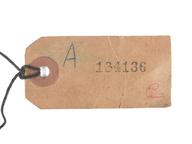









Cake of chalky earth, to increase milk flow, from Bethlehem, Palestine, 1920-1930
This tablet of white chalky earth from the Milk Grotto in the holy city of Bethlehem was intended to be eaten. The eating of earth sounds unusual but is by no means uncommon and has a long history. Sometimes eaten in times of desperate famine, earth eating (known as geophagy) is particularly associated with pregnant and nursing women. Pregnancy and lactation require a higher nutritional intake. In areas where the diet is traditionally poor, cravings for additional nutrition can be assisted by eating clay tablets which can contain a range of essential elements, such as potassium, zinc and magnesium.
That this clay was said to come from the site where Christians believe the Virgin Mary stopped to breastfeed Jesus as they fled to Egypt would have given it a special significance. It may well have been brought back from a religious pilgrimage. The earth is shown here with a similar example (A669204).
Details
- Category:
- Ethnography and Folk Medicine
- Collection:
- Sir Henry Wellcome's Museum Collection
- Object Number:
- A669205
- Materials:
- earth
- Measurements:
-
overall: 17 mm 41 mm, .032 kg
- type:
- terra sigillata




